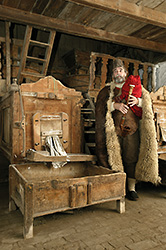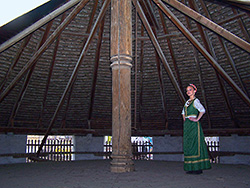Reminder
IN KIKINDA, BEFORE THE LAST SUVAČA OF VOJVODINA
Mill It Finely, Black Horses
All horse mills in Bačka used to be called ”suvaje”, and in Banat ”suvače”. Certainly, they are some of the most significant examples of folk architecture. The earliest preserved mention of suvače in Banat is from 1727. It is believed that they were present even before, because Evlija Čelebija in the 17th century mentions 600 horse drawn suvače and mills on the Danube near Belgrade. Of all of them only one survived and stories, customs and beliefs are still being made about it, and some might even begin to sing
By: Marina Gorski
 Most of these mills were located in Banat. There was not a place without at least one, but usually there would be ten, even twenty, and in some places over thirty. In 1855, Bavanište had 34 horse mills, in 1847, Kikinda had 51 of them. In Great Kikinda District, that same year, 252 horse mills were in operation, approximately one on every 370 people. Although they were primarily used to grind cereal, they were also used for hemp processing. Most of these mills were located in Banat. There was not a place without at least one, but usually there would be ten, even twenty, and in some places over thirty. In 1855, Bavanište had 34 horse mills, in 1847, Kikinda had 51 of them. In Great Kikinda District, that same year, 252 horse mills were in operation, approximately one on every 370 people. Although they were primarily used to grind cereal, they were also used for hemp processing.
The only remaining horse mill in Vojvodina, the one in Kikinda, is still standing ”asleep in memories”. From 1899, and for 46 years after that, it was bringing together endless stories of millers and their clients, rattle and squeak of spindle and wheel, clatter of horses, hum of cereal grains full of villagers’ sorrow and life, whiteness of flour and darkness of the night, joy and tragedy.
”Yes, that was pure flour without impurities. After making and baking bread, grandmothers and wives would put the loaves in the hallway, toward the street. The best bread was made from flour ground in horse mills. Housewives used that flour to mage dough around the table and were making small buns. Not many people suffered from stomach diseases when they were eating bread from horse mill flour”, we read from the notes of Rado Petkov Mamula from Kikinda. (We keep it together with stories of many others who were smelling these times, and now we know where they all came from.)
Thirty villagers joined in a cooperative, and with their joint money, and borrowed money from the First District Savings Bank of the Great Kikinda District they purchased a mechanism of one horse mill from Padej. The building of horse mill Kikinda, this one that is standing before us today, had already been built.
 There were other horse mills in Kikinda at that time, two wind mills, steam mills, but the villagers wanted to grind their own cereal for their own needs. It was cheaper and better. The commission was 5-6, maximum 8 percent. There were other horse mills in Kikinda at that time, two wind mills, steam mills, but the villagers wanted to grind their own cereal for their own needs. It was cheaper and better. The commission was 5-6, maximum 8 percent.
That horse mill used to mill everything: wheat, oat and corn, clover seed, black pepper, cinnamon, paprika.
”It would sometimes mill night and day”, an old many told us long time ago, with a spark in his eye. He is still talking, through the journalist’s quill. ”There were many clients, because they were also coming from neighboring villages. They would write their names on the millers’ board so that they would know their order. There used to be as many as twenty clients in the large waiting room. They would even bring their firewood, they would make fire and wait in the warm room, talk about the war and play cards, and us kids would just take a peek there.”
FROM THE FLOOR TO THE SKY
Horse mills used to be built at the end of the village, because they were noisy, but also very flammable. They were mostly made of wood (beech, hornbeam, ash, oak, acacia). In order to make the building strong and durable, the foundations of the horse mill would be sprinkled with blood of a butchered rooster, and its head would be built in the corner, on the eastern side, between four bricks. They would also build in money and incense holder, sometimes a glass filled with wine, for good luck, help of God and host’s health.
Horse mill is made of: a department of conical or pyramidal roof (where there is the device that moves millstones, big wheel and shafts), milling part of the mill (where there are millstones, crates with sieves and other elements of the mechanism) and miller’s apartment.
 Roof of a horse mill is in the shape of fourteen-sided pyramid pointed on top. The roof structure rests on fourteen built pillars. Between pillars there is enclosure made of wooden strips and door through which the horses were brought inside the mill. (Some mills did not have enclosure and accidents used to happen.) Height from the floor to the roof, in the centre of the mill, is eight and a half meters. The top of the interior part of the roof is called ”the sky”. Roof of a horse mill is in the shape of fourteen-sided pyramid pointed on top. The roof structure rests on fourteen built pillars. Between pillars there is enclosure made of wooden strips and door through which the horses were brought inside the mill. (Some mills did not have enclosure and accidents used to happen.) Height from the floor to the roof, in the centre of the mill, is eight and a half meters. The top of the interior part of the roof is called ”the sky”.
In the interior part of the roof, on the very top, there is a support of the round roof spike, supporting the beams holding the roof. In the centre of the mill there is a pole called ”popa”. On its bottom part there is a big wheel, with circumference of 45 meters, with 516 teeth. On the bottom part of the pole there is a metal bearing inserted in a wooden base (”paprica”).
The villagers used to bring their horses to mill their own cereal. Once finished, the mill would stop, the grain owner would release his horses and take them outside, and the next person in line for milling would bring in his horses.
”The villagers were bringing grain, usually 50 kilograms on two horses, and they would mill it in about one hour. Therefore, one meter on two horses, if they are stronger, but maximum of three or four horses. Those who had stronger horses would operate both millstones, so they would mill as much as two meters. One was used for corn, rye or oat, and the other for wheat. The mill was also making grits, only the sieve would be placed differently”, we hear from Rade Mamula.
 And how it was for horses, we learn from folk sayings. For a lazy person they say: ”He is rushing like a horse into a horse mill.” When something is being done reluctantly: ”His heart is pounding like horse’s for a horse mill.” For a yong man or girl who are getting into a loveless marriage: ”He loves her as a horse loves horse mill”. It is written that in 1863, in some horse mills in Banat, but not in this one in Kikinda, poor villagers used to turn the mill wheel themselves. And how it was for horses, we learn from folk sayings. For a lazy person they say: ”He is rushing like a horse into a horse mill.” When something is being done reluctantly: ”His heart is pounding like horse’s for a horse mill.” For a yong man or girl who are getting into a loveless marriage: ”He loves her as a horse loves horse mill”. It is written that in 1863, in some horse mills in Banat, but not in this one in Kikinda, poor villagers used to turn the mill wheel themselves.
In early winter, when there was great demand for milling, villagers could harness as many as twelve horses in six pairs. In such periods the mill would work day and night.
”The villagers would then bring wine and start to sing. Some were in Russia, so they new how to sing in Russian. We, the children, would peek in or come in”, Rada Petkov remembered. ”Jokes were plentiful. People were playing cards: štika (similar to tablić) and duraka (the one who loses must bray like a donkey and he was called durak, meaning madman).”
There are no longer among us those who remember the times when the horse mill was rattling and producing the best flour in the world. Written accounts remain, and there are also traces in the language. We did not forget them. Let us also not forget the only remaining horse mill in Kikinda, on the corner of Nemanjina and Moravska streets in Kikinda, which has been dormant since 1945, on the heavy soil, with cover made of sky and wake.
***
The first
New flour from horse mil was used to make novina or prvina – cakes or flatbread. They were given to neighbors or relatives. One cake would be thrown into the well ”so there would be as much bread as cold water”. Girls would eat them so they would get married as soon as possible, or carry them in the pocket of their vests, ”so their betrothed would always be close to their hearts”.
***
Celebrations
In Vršac and the surroundings, people used to celebrate the day when horse mill was built, namely when the first ceremony was made to mark the completion of the roof structure. Powerful music of gajde players and song would be heard far, to the centre of the village or town, and as if we can still hear that echo today. In North Banat, millers also celebrated the Clean Monday, the first day of the Easter lent, when all kitchen utensils would be cleaned from grease by boiling them in a big vessel and lye.
***
Commission
Operation of a horse mill was managed by the suvačar (miller). There were cases when the owner or tenant was managing the operation, if they were trained millers. A commission would be taken from the brought cereal, and this commission would be kept in the attic. They would sell it, as needed, to pay for repair of the mill, by grease for lubrication, kerosene for lamps, top pay taxes and others. A part of that commission would be given to the miller, who had to account for, every night after the work would be finished, how much cereal he milled that day.
|
